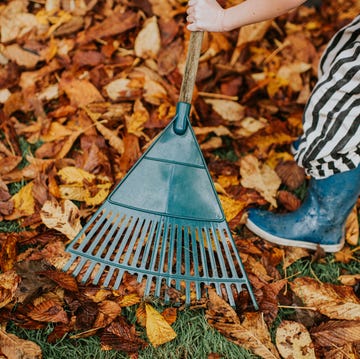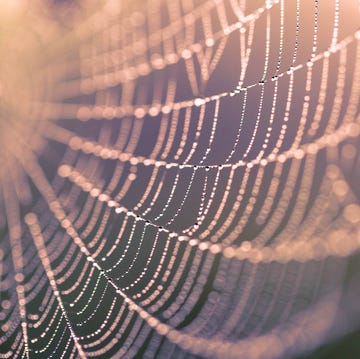Whether you love them for their cheerful look, think they’re a sign of good luck, use them as inspiration for canapés a la Meghan Markle or, like Good Housekeeping’s very own Simon Swift, see them as ‘the strawberry of the insect world’ (in terms of cuteness, not for eating), ladybirds are one of the most beloved of the bug kingdom. Fun fact: a group of ladybirds is known as a ‘loveliness’.
But, as much as we're ladybird fans, they're appearing in disconcerting numbers around the UK right now, even stopping play in the cricket at Lord's last week. They've been spotted in record numbers in recent months (one even flew into one GH colleague's open mouth).
It was bugging us, so we had to speak to the experts to find out why they're everywhere right now, and whether there are any risks to this sudden siege.
What to read next
Why are there so many ladybirds this year?
If you’ve noticed more ladybirds than usual fluttering around your garden, windowsills or even joining you on a sunny picnic, you’re not imagining it. 2025 is turning out to be a bumper year for these beloved little beetles.
‘There are many factors that lead to the very high numbers of ladybirds we're seeing at the moment,’ says Professor Helen Roy of the UK Centre for Ecology & Hydrology and the University of Exeter, ‘
‘Ladybirds emerged from their winter dormancy in good numbers after a favourable winter, and fortunately there were high numbers of aphids (greenfly), which are the favoured food of many ladybird species.’
That early feast, thanks to a dry spring, followed by bursts of humid summer weather during this year’s seemingly endless back-to-back heatwaves, has set the stage for a ladybird baby boom. ‘The good supply of aphids and the warm weather enabled the new generation of ladybirds to flourish and rapidly complete their life cycle,’ says Professor Roy.
Some of the bugs you’re seeing may be harlequin ladybirds, an invasive species known for gathering in large numbers. While they’re mostly harmless, they can sometimes surprise people by appearing indoors or clustering on garden furniture. Other common types include the seven-spot ladybird, the one I grew up believing to be a sign of good luck. At this current rate of ladybird spottings, the rest of 2025 is set to be a calendar year of good fortune.
Do ladybirds pose a threat?
As a kid in the countryside, I also grew up being told that yellow ladybirds were poisonous and could kill you if you touched them. But I’m sure you don’t need me, or Professor Roy, to tell you that’s utter nonsense. Ladybirds are harmless, so this invasion is more of a visual spectacle than anything to be concerned about.
These stylish little beetles (we love a polka dot) don’t sting, they’re not poisonous (as I eventually learned as an adult), and they don’t pose a health risk to people or pets. In fact, they’re considered a gardener’s best friend because they munch through greenfly and other pests.
That said, there are a couple of minor downsides to be aware of, especially with the harlequin ladybird, a non-native species that’s become increasingly common in the UK. Harlequins can gather in large groups, particularly on sunny walls or indoors as they seek shelter. In rare cases, they may emit a yellowish liquid (called reflex bleeding). This is a defence mechanism but it’s harmless. The worst it could do is stain your clothes and emit a slightly odd smell.
‘Unfortunately, harlequin ladybirds are particularly voracious,’ states Professor Roy, ‘and as aphid numbers drop, they will have a greater propensity to feed on a range of different insects. Harlequin ladybirds have been implicated in the decline of 2-spot ladybirds.’
Why you should leave the ladybirds alone
So, as tempting as it might be to swat away a swarm or sweep ladybirds out of sight, the truth is, they’re doing far more good than harm.
Ladybirds are natural pest controllers. A single adult can eat dozens of aphids in a day, protecting your roses, vegetables and houseplants without the need for chemical sprays. By leaving them to get on with their work, you’re supporting a healthier, more balanced garden.
Their presence is also a positive sign of a healthy, biodiverse space. ‘It is wonderful to see ladybirds in high numbers,’ says Roy. ‘People should enjoy and celebrate seeing ladybirds… They play important roles within our ecosystems.’ They provide food for birds and help keep insect populations in check. So take it as a compliment when you see them buzzing around your home.
Professor Roy suggests gardeners could help our bug-eyed friends out, “by ensuring they leave aphids (greenfly) in their gardens, provide shallow dishes of water with a few stones to provide platforms for insects and, at the end of the summer, leave some wild patches that will be excellent winter habitats for ladybirds and other insects.’
If they come indoors, it’s usually by accident or in search of warmth. There’s no need to panic. Gently scoop them up and release them outside, where they’ll be much happier.
If you do see a serious amount of ladybirds this summer, you can contribute to the research and conservation of the creatures. Professor Roy encourages us all to submit our sightings to iRecord to help contribute to our understanding of the ecology of ladybirds.
A little kindness goes a long way when it comes to nature's best-dressed little bugs.














